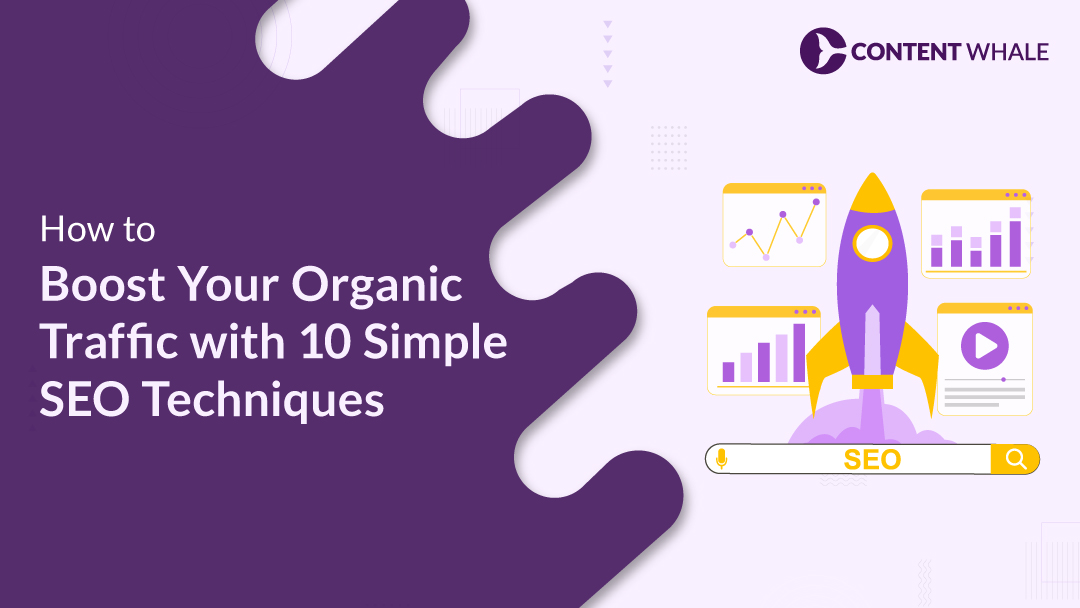Driving organic traffic to your website is essential for staying competitive in 2024’s digital space. With millions of websites competing for attention, SEO techniques play a pivotal role in improving your search results ranking, Increase Organic Traffic and reaching your audience.
The good news? Effective SEO strategies are within your reach, whether you’re a small business owner or managing a large online platform.
This guide will walk you through 10 practical SEO best practices to increase organic traffic, covering everything from on-page SEO to backlink building.
Here’s a table summarizing the SEO techniques covered, including their detailed descriptions and benefits:
| # | SEO Technique | Description | Benefits |
| 1 | Conduct Thorough Keyword Research | Identifying high-volume, low-competition keywords and long-tail phrases that match user intent using tools like SEMrush and Ahrefs. | Improves visibility, attracts targeted traffic, and enhances content relevance for better rankings. |
| 2 | Recognize Search Intent | Understanding and optimizing content for different types of search intent: informational, navigational, transactional, and commercial investigation. | Increases relevance, engagement, and conversion rates by aligning content with user needs. |
| 3 | Create High-Quality, User-Centric Content | Producing content that addresses user pain points, includes relevant keywords, and is regularly updated for freshness. | Boosts user engagement, dwell time, and search rankings, while reducing bounce rates. |
| 4 | Optimize On-Page Elements | Enhancing meta titles, descriptions, header tags, and image alt text to improve content structure and keyword placement. | Improves search engine crawling, content indexing, and user experience. |
| 5 | Improve Mobile Experience | Ensuring the website is mobile-friendly, with responsive design and optimized content for mobile-first indexing. | Enhances mobile search rankings, user experience, and engagement. |
| 6 | Boost Page Speed | Reducing page load times through image compression, caching, and minimizing code. | Improves user satisfaction, lowers bounce rates, and positively impacts rankings. |
| 7 | Leverage Video SEO | Optimizing video titles, descriptions, transcripts, and thumbnails, and using schema markup for better indexing. | Increases visibility in video search results, boosts engagement, and attracts more organic traffic. |
| 8 | Optimize Content for Featured Snippets | Structuring content to answer queries directly, using lists, tables, and schema markup to appear in position zero. | Improves chances of appearing in featured snippets, leading to increased click-through rates and visibility. |
| 9 | Build High-Quality Backlinks | Acquiring backlinks from authoritative sites through strategies like the Skyscraper technique, digital PR, and guest blogging. | Enhances domain authority, improves search rankings, and drives referral traffic. |
| 10 | Use Long-Tail Keywords | Targeting longer, specific phrases that reflect detailed queries to attract highly relevant traffic. | Increases conversion rates, ranks for less competitive terms, and captures users with clear search intent. |
| 11 | Use Social Media to Promote Webpages | Sharing content on social media platforms to increase visibility and drive traffic to the website. | Amplifies content reach, boosts referral traffic, and encourages social shares and backlinks. |
| 12 | Implement Technical SEO | Enhancing website architecture through schema markup, XML sitemaps, and fixing broken links and crawl errors. | Improves crawlability, indexing, and search engine understanding of website content. |
| 13 | Monitor Performance with Analytics | Using tools like Google Analytics and SEMrush to track organic traffic, keyword rankings, and user behavior data. | Provides insights for refining SEO strategies, improving content, and increasing overall site performance. |
By following these detailed actionable steps, you’ll be able to boost your website traffic and stay ahead of your competition in the ever-changing world of search engine optimization.
1. Conduct Thorough Keyword Research
Effective keyword research is foundational for boosting organic traffic. In 2024, mastering keyword research requires more than finding popular terms. Here’s how you can optimize your strategy:
A) Understand Search Intent
- Categorize keywords based on intent: informational, transactional, or navigational. Matching your content with user intent ensures higher search results ranking and better engagement.
- Tools like Ahrefs and SEMrush provide insights into keyword intent, helping tailor your content to meet user expectations.
B) Leverage AI-Powered Tools
- Modern tools utilize AI insights to suggest keywords aligned with trends and search engine algorithms.
- Platforms such as Moz offer features for predicting search trends and analyzing keyword relevance.
C) Target Long-Tail Keywords
- Use longer, specific phrases to attract qualified traffic. These keywords typically have lower competition and lead to higher conversion rates.
- For example, opt for “SEO techniques for small businesses in 2024” instead of just “SEO techniques” to reach a niche audience.
D) Perform Competitor Analysis
- Analyze competitor keywords to identify content gaps. This approach not only boosts your SEO techniques but also uncovers potential content opportunities.
- Tools like SEMrush show which keywords competitors are ranking for, guiding your strategy.
E) Organize Keywords into Topic Clusters
- Group related keywords to build topical authority. This helps establish your content’s depth, making it more visible in engine results pages (SERPs).
- Creating clusters around a central theme improves your chances of ranking for multiple organic traffic boosting strategies.
2. Recognize Search Intent
Mastering search intent is vital for implementing effective SEO techniques that increase organic traffic. As search engine optimization evolves, aligning content with what users are looking for can significantly impact your search results ranking. Here’s how to approach it:
A) Different Types of Search Intent
- Informational Intent: When users seek knowledge, they typically search for answers, definitions, or how-tos. Content that provides thorough explanations or step-by-step guides addresses this need. For instance, creating posts on “Top SEO best practices for 2024” targets informational queries.
- Navigational Intent: Users searching for specific websites or brands use navigational keywords. Optimizing for branded terms can help capture this traffic and increase website traffic.
- Transactional Intent: These users are ready to buy. Optimizing landing pages for high-converting keywords and including structured data can help improve visibility in organic traffic boosting strategies.
- Commercial Investigation: Users compare products or seek reviews before making a decision. Optimizing content with comparison keywords and topic clusters can improve conversion rate and organic traffic.
B) Why Understanding Search Intent Matters in 2024
- As search engine algorithms prioritize user-centric content, aligning with search intent helps achieve higher rankings and secures spots in SERP features like featured snippets, video SEO, or the “People Also Ask” section.
- Addressing intent correctly can improve metrics like user experience and page speed optimization, impacting overall SEO performance.
C) Optimizing Content for Intent
- Use keyword research tools to assess the dominant intent behind search terms.
- Format your content accordingly—guides, lists, product reviews, etc.—to enhance both on-page SEO and content marketing effectiveness.
3. Create High-Quality, User-Centric Content
Producing high-quality content is essential to increase organic traffic and enhance your search engine optimization efforts. In 2024, content that addresses user needs with depth, relevance, and accuracy remains at the forefront of SEO best practices.
A) Focus on User Intent
- Content must align with user expectations and search intent. Address the specific pain points and questions your target audience has, whether they are searching for information, products, or services. This can significantly improve your search results ranking.
- Use keyword research to identify content topics that resonate with user queries. Aim to provide comprehensive answers that fulfill the searcher’s needs, whether through how-to guides, detailed articles, or product reviews.
B) Prioritize Content Freshness
- Updating existing content to keep it relevant is essential for sustaining organic traffic. Regularly refreshing articles with new data, trends, or insights ensures they remain competitive in the engine results pages (SERPs). Google continues to favor content that is kept current and accurate.
- Incorporate elements like content freshness and structured data to improve visibility and user engagement.
C) Utilize Various Content Formats
- Diverse content formats such as video SEO, infographics, and case studies can help retain user attention and boost the user experience. Videos, in particular, are effective for increasing dwell time and lowering bounce rates.
- Voice search optimization is becoming more important as voice queries gain popularity. Using conversational language and natural phrases can help optimize content for voice-based searches.
D) Build Topical Authority
- Creating in-depth content that explores all related subtopics helps establish topical authority, making your site more likely to rank for multiple organic traffic strategies. Utilize topic clusters and internal linking to connect related content.
- Incorporating high-quality backlinks and engaging in content marketing will further solidify your authority in your niche.
| # | Steps | Description |
| 1 | Understand Your Audience | Identify your target personas, their preferences, and pain points. Use data analytics and social media listening to tailor content to their needs. |
| 2 | Conduct Keyword Research | Use tools like Google Keyword Planner, SEMrush, and Ahrefs to find high-value, relevant keywords that match search intent and user expectations. |
| 3 | Plan Content Around User Intent | Ensure content directly answers user questions or solves their problems. Focus on creating content that matches their search intent. |
| 4 | Create Engaging, Helpful Content | Produce detailed, well-structured, and relevant content that is easy to digest, using headings, lists, and multimedia for better user engagement. |
| 5 | Incorporate SEO Best Practices | Optimize titles, meta descriptions, headers, and images. Use long-tail keywords and structure content for both readability and searchability. |
| 6 | Ensure Content Freshness | Regularly update your content to keep it relevant and aligned with current trends. This helps maintain search results ranking and engagement. |
| 7 | Measure and Optimize Performance | Use tools like Google Analytics to track performance, user behavior, and adjust your content strategy accordingly for better results. |
4. Optimize On-Page Elements
Fine-tuning your on-page SEO is essential for boosting organic traffic and enhancing your website’s presence in search results. By optimizing various on-page elements, you can significantly improve your search results ranking and increase website traffic.
A) Craft Compelling Meta Titles and Descriptions
- Your meta title should include the primary keyword, ideally placed near the beginning, to signal relevance to search engines. For instance, front-loading phrases like “Boost Organic Traffic” can improve search engine optimization outcomes.
- The meta description should summarize the page’s content and include relevant keywords naturally. Aim for under 160 characters to ensure it displays fully in SERP features. An engaging meta description can boost click-through rates, signaling content value to search engines.
B) Use Header Tags Strategically
- Organize your content using header tags (H1, H2, H3, etc.) to make it easier for users to scan and for search engines to understand the structure. Include secondary keywords in subheadings where they fit naturally, as this supports better keyword optimization.
- Ensure you have only one H1 tag per page, clearly defining the topic, with other headers outlining subtopics and related content, enhancing user experience.
C) Optimize Images for SEO
- Use descriptive filenames and add alt text that includes keywords when relevant. This not only boosts image SEO but also improves accessibility. Compress images to maintain fast page speed, a known ranking factor for search engine algorithms.
- Incorporating engaging visuals and videos can increase dwell time and lower bounce rates, positively impacting your site’s organic traffic strategies.
D) Internal and External Linking
- Add internal links to guide users to related content and improve site structure, supporting topic clusters. External links to high-quality sources can build credibility, signaling to search engines that your content is well-researched.
| # | Steps | Description | Benefits |
| 1 | Craft Keyword-Rich Title Tags | Use keywords in concise titles under 60 characters. | Increases visibility and relevance in search results. |
| 2 | Write Compelling Meta Descriptions | Summarize content with keywords in 160 characters or less. | Boosts click-through rates. |
| 3 | Use Header Tags (H1, H2, H3) | Organize content with header tags and include keywords. | Improves readability and search engine understanding. |
| 4 | Optimize Image SEO | Add descriptive alt text and compress images. | Enhances image search visibility and site speed. |
| 5 | Add Internal and External Links | Link to relevant pages with descriptive anchor text. | Improves site authority and navigation. |
| 6 | Use Short, Keyword-Rich URLs | Create simple URLs with main keywords. | Makes URLs more relevant and SEO-friendly. |
| 7 | Optimize Content for Readability | Break up text with lists, bullet points, and paragraphs. | Enhances user engagement and dwell time. |
| 8 | Include Structured Data (Schema Markup) | Add schema to help search engines understand content context. | Increases chances of appearing in rich snippets. |
| 9 | Ensure Mobile Friendliness | Use responsive design for various screen sizes. | Improves mobile rankings and user experience. |
| 10 | Regularly Update Content | Refresh content to keep it current and relevant. | Sustains rankings and enhances content freshness. |
5. Improve Mobile Experience
Optimizing for mobile-first indexing is essential for boosting organic traffic in 2024. With more users accessing the web via mobile devices than ever before, enhancing your website’s mobile experience can significantly improve your search results ranking and increase website traffic. Here’s how to do it:
A) Embrace Responsive Design
- A responsive design ensures your website automatically adjusts to various screen sizes, providing a seamless experience on smartphones and tablets. Google’s mobile-first indexing now prioritizes mobile-friendly pages, making a responsive design a vital part of your SEO techniques. This optimization can reduce bounce rates and increase engagement, which are positive signals for search engine algorithms.
B) Prioritize Page Speed Optimization
- Page speed optimization is critical for a smooth user experience on mobile. Slow-loading pages can drive users away, negatively impacting conversion rates. Use tools like Google PageSpeed Insights to compress images, enable browser caching, and minimize code (HTML, CSS, and JavaScript). These adjustments not only improve page speed but also align with SEO best practices for both desktop and mobile.
C) Structure Mobile-Friendly Content
- Short paragraphs, bullet points, and descriptive subheadings make content easier to read on smaller screens. Use structured data to help search engines understand your content better, potentially earning you spots in featured snippets. Additionally, optimize for voice search by including natural language phrases that mobile users might use.
D) Regular Testing and Monitoring
- Use tools like Google’s Mobile-Friendly Test to regularly evaluate your site’s mobile performance. Monitoring metrics such as mobile traffic, search engine results pages (SERPs) rankings, and bounce rate can guide further improvements. Addressing any issues promptly ensures your site remains in line with mobile-first SEO strategies.
Here’s a benefit for improving the mobile experience:
| # | Benefits | Description |
| 1 | Improved Search Rankings | Mobile-friendly sites rank better due to mobile-first indexing. |
| 2 | Enhanced User Experience | Responsive design and touch-friendly elements boost engagement and retention. |
| 3 | Higher Conversion Rates | Faster load times and intuitive navigation lead to more completed actions. |
| 4 | Lower Bounce Rates | Mobile optimization reduces bounce rates, signaling valuable content to search engines. |
| 5 | Increased Mobile Traffic | Optimized sites capture more mobile users, driving higher organic traffic. |
| 6 | Better Local SEO Performance | Location-based optimizations attract nearby customers and improve local search visibility. |
| 7 | Access to Rich SERP Features | Structured, mobile-optimized content is more likely to appear in featured snippets. |
6. Boost Page Speed
Improving page speed is a top priority for enhancing organic traffic in 2024, as slow-loading sites often result in higher bounce rates and lower conversion rates. Here’s how you can optimize your website’s loading speed effectively:
A) Minimize File Sizes
- Compress images to reduce their size without compromising quality. Use formats like WebP for smaller file sizes and better performance. Additionally, leverage tools like Gzip to compress CSS and JavaScript files, making them load faster.
- Minify CSS and JavaScript by removing unnecessary characters and whitespace. This optimization decreases file sizes, reducing loading times and improving the time it takes for the browser to parse and execute code.
B) Leverage Browser Caching
- Caching stores static resources (e.g., images, scripts) on the user’s device, allowing quicker loading on subsequent visits. Set appropriate cache expiration dates to ensure updated content is served as needed. This is especially important for maintaining an optimal user experience.
C) Use a Content Delivery Network (CDN)
- A CDN distributes your content across multiple servers globally, delivering it from the location closest to the user. This reduces latency and improves page speed optimization, making your site more responsive.
D) Reduce HTTP Requests
- Minimize the number of elements on each page that require separate HTTP requests. Combine multiple CSS or JavaScript files into one, and use lazy-loading techniques for images to load them only when needed.
7. Leverage Video SEO
Video SEO plays an increasingly vital role in 2024, as more users consume video content across various platforms. To increase organic traffic and enhance your SEO techniques, it’s essential to optimize video content effectively for search engines. Here’s how:
A) Optimize Video Titles and Descriptions
- Include relevant keywords naturally in the video title to help search engines understand the topic. Titles should be concise, ideally under 60 characters, to avoid truncation in search engine results pages (SERPs). Using numbers or questions in titles, such as “5 Tips for Better Video SEO,” can attract more clicks.
- Video descriptions should be detailed and contain target keywords. Start with a compelling opening line to grab attention and provide additional context for the video content. This strategy improves your chances of ranking in both traditional search results and video-specific sections.
B) Add Transcripts and Captions
- Including video transcripts boosts accessibility and allows search engines to index more content, increasing the potential for higher rankings. Captions can also improve user experience, making the content more engaging for viewers who prefer or need text support.
C) Create Eye-Catching Thumbnails
- Thumbnails serve as the visual representation of your video in search results. Make sure they are appealing and relevant to the content. Use high-quality images that resonate with your audience and drive click-through rates (CTR). Eye-catching thumbnails can make your video stand out in a crowded SERP.
D) Use Schema Markup for Videos
- Implementing structured data like VideoObject schema provides search engines with detailed information about your video content. This helps in appearing in rich results such as featured snippets, improving visibility.
E) Embed Videos on Relevant Pages
- Placing videos on related web pages can enhance on-page SEO. This approach not only boosts video engagement but also contributes to longer site visits, potentially increasing your site’s conversion rate.
8. Optimize Your Content for Featured Snippets
Securing a spot in featured snippets can significantly increase organic traffic and boost visibility. Here’s how you can optimize content to improve your chances of appearing in these prominent search positions:
A) Answer Queries Directly
- Provide clear, concise answers to frequently asked questions. For paragraph snippets, aim for responses between 40-60 words that directly address the query. Use headings to signal the question being answered, which helps search engines identify relevant content more easily.
- When structuring answers, consider using the inverted pyramid technique—start with the most essential information and then delve into more details. This approach caters to users seeking quick answers while ensuring the content remains valuable for further reading.
B) Utilize Lists and Tables
- For list snippets, structure content with numbered or bulleted lists. This works well for “how-to” guides or step-by-step instructions. Each step should be clear and concise, as Google often pulls list items from various headings within a page.
- Use tables for content involving comparisons, such as pricing or product features. A well-formatted table can make data more digestible and increase the likelihood of appearing in a table snippet.
C) Incorporate Long-Tail Keywords
- Target long-tail keywords as they often trigger snippet opportunities due to their specificity. These keywords align well with user intent, increasing your chances of ranking higher in search engine results pages (SERPs).
D) Implement Schema Markup
- Use structured data like FAQ and HowTo schema to help search engines understand the context of your content. Schema markup increases the chances of your content being featured in rich results.
Here’s a table with steps to optimize content for featured snippets, along with their descriptions:
| # | Step | Description |
| 1 | Identify the Right Queries | Target keywords and questions that are likely to trigger featured snippets using tools like SEMrush. |
| 2 | Provide Concise Answers | Keep answers around 40-60 words for paragraph snippets; be direct and address the query upfront. |
| 3 | Use Structured Content | Organize content with question-based headings (H2/H3), lists, and tables to make it easier for Google. |
| 4 | Implement Schema Markup | Use structured data like FAQ or HowTo schema to help search engines understand the content better. |
| 5 | Keep Content Updated | Regularly refresh your content to ensure it remains relevant and aligned with current search trends. |
9. Build High-Quality Backlinks
Acquiring high-quality backlinks is a key factor in increasing organic traffic and improving your search results ranking. In 2024, focusing on relevant and authoritative links is more important than ever. Here are some effective strategies to enhance your link-building efforts:
A) Use the Skyscraper Technique
- The Skyscraper Technique involves finding top-performing content in your niche, creating an improved version, and reaching out to sites that link to the original content to share your updated resource. Make your content more comprehensive, up-to-date, and visually appealing than the competition. This approach can attract high-quality links from authoritative sites and boost your SEO techniques.
B) Leverage Digital PR and HARO
- Engaging in digital PR can help you gain coverage on news sites, blogs, and other publications. Create compelling stories or campaigns relevant to current trends to get your brand mentioned in articles, earning valuable backlinks. Additionally, use platforms like HARO (Help A Reporter Out) to connect with journalists seeking expert insights, increasing your chances of getting featured with a dofollow backlink.
- These efforts help build brand authority while also generating links that support organic traffic boosting strategies.
C) Create Linkable Visual Assets
- Infographics, charts, and videos are excellent for earning backlinks, as they provide valuable information in a shareable format. Publish these assets on your site, and offer them with embed codes to encourage others to link back to you. High-quality visuals can naturally attract links and improve your search engine optimization efforts.
D) Replicate Competitors’ Backlinks
- Conduct a link gap analysis to identify websites linking to your competitors but not to you. Reach out to these sites with compelling reasons why they should link to your content. This strategy can close the backlink gap and increase website traffic by acquiring links from already interested sources.
E) Utilize Guest Blogging Effectively
- While guest blogging can be risky if done improperly, publishing high-quality posts on authoritative sites relevant to your niche can still generate valuable backlinks. Focus on offering genuine insights rather than keyword-stuffed content, ensuring each link adds value to the host site.
Here’s a benefit of building high-quality backlinks with concise descriptions:
| # | Benefits | Description |
| 1 | Improves Search Rankings | High-quality backlinks signal to search engines that your site is credible, boosting rankings. |
| 2 | Increases Organic Traffic | Better rankings in search results drive more organic visitors to your website. |
| 3 | Enhances Domain Authority | Backlinks from reputable sites raise your site’s domain authority, making it more trustworthy. |
| 4 | Builds Brand Credibility | Gaining links from authoritative sites helps establish your brand as an expert in your industry. |
| 5 | Supports Long-Term SEO Success | Quality backlinks provide lasting value, ensuring sustained improvements in search visibility. |
| 6 | Expands Referral Traffic | Links from high-traffic sites can generate direct referral traffic to your website. |
| 7 | Facilitates Faster Indexing | Search engines crawl and index pages linked from other authoritative sites more quickly. |
| 8 | Strengthens Content Visibility | Backlinks enhance the reach and visibility of your content across the web. |
10 .Use Long-Tail Keywords
Targeting long-tail keywords is a powerful strategy for increasing organic traffic in 2024. These highly specific phrases attract qualified visitors who are more likely to convert, as they often indicate clear search intent. Here’s how to effectively leverage long-tail keywords in your SEO techniques:
A) Understand the Benefits
- Long-tail keywords are longer, more specific phrases that reflect detailed search queries, such as “best DSLR camera for wildlife photography under $1000.” These keywords typically face less competition than broad terms, making it easier to achieve higher search results ranking and increase website traffic.
- Users searching with long-tail keywords are often further along the buying process, leading to better conversion rates. They are looking for specific information, products, or solutions, making them more likely to take action on your site.
B) Find the Right Long-Tail Keywords
- Use tools like SEMrush, Ahrefs, or Google Keyword Planner to discover long-tail keywords with lower competition but relevant search volume. These tools can also identify gaps in your content where you can capitalize on underused keywords.
- Explore sources like customer reviews, forums, and social media to understand the exact language your audience uses, turning those phrases into effective long-tail keywords.
C) Optimize Content Naturally
- Incorporate long-tail keywords throughout your content in a natural and readable way. Use them in headings, meta descriptions, and the body text to improve on-page SEO. Answering specific questions or addressing user concerns with these phrases can increase your chances of ranking in featured snippets and other SERP features.
Conclusion
Increasing organic traffic requires a strategic approach that combines multiple SEO techniques to improve your website’s visibility and rankings. By following the steps outlined in this guide—from keyword research and on-page SEO to backlink building and video SEO—you can implement effective strategies that drive sustainable growth.
Focusing on user intent, creating high-quality content, and optimizing for both page speed and mobile-first indexing ensures a comprehensive approach to search engine optimization.
Remember, SEO is not a one-time effort but an ongoing process. Regularly update your content to maintain content freshness, monitor changes in search engine algorithms, and adapt your strategies accordingly.
Consistency in applying these organic traffic boosting strategies will help your site stay competitive in the engine results pages (SERPs).
At Content Whale, we specialize in crafting optimized content that aligns with search intent, improves search results ranking, and drives qualified traffic, ensuring sustainable growth for your business.
Let us help you to increase your website’s organic traffic with our expert SEO content writing services.
FAQs
- How long does it take to see results from SEO?
SEO results typically start appearing within 3 to 6 months, depending on factors like competition, keyword difficulty, and content quality. Consistency in applying SEO techniques and regularly updating your content can help achieve faster improvements in search results ranking.
- What is the most important factor in boosting organic traffic?
Creating high-quality, user-centric content that aligns with search intent is essential. Optimizing for relevant long-tail keywords, improving page speed, and focusing on on-page SEO can significantly increase organic traffic.
- How often should I update my content for SEO?
It’s recommended to update your content every 6 to 12 months to maintain content freshness. Refreshing information, adding new insights, and optimizing for the latest SEO best practices help retain and improve your search engine rankings.
- Can mobile optimization really impact my rankings?
Yes, mobile-first indexing means Google uses the mobile version of your site for ranking and indexing. A mobile-friendly website improves user experience, leading to better search results ranking and increased website traffic.
- What tools can help me track SEO performance?
Tools like Google Analytics, SEMrush, and Ahrefs can monitor metrics such as organic traffic, keyword rankings, and conversion rates, helping you fine-tune your SEO strategies based on data insights.
- How does search intent affect SEO strategies?
Aligning content with search intent ensures it meets user needs, improving engagement and search engine optimization. Matching your content to what users are searching for increases the chances of higher visibility in engine results pages (SERPs).





